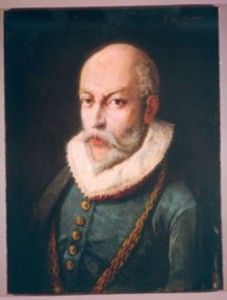[The following are the program notes for First Vespers of the Solemnity of Mary, the Mother of God, to be celebrated Monday, December 31 at 5:15 p.m. We hope that many of you can join us and ring in the new year with this beautiful celebration!]
So begins tonight’s beautiful hymn, employing the first of several wordplays scattered throughout the text. The similarity of the name Maria and the Latin word for “sea” (mare) combined with the image of the Church as the Barque of Peter to make of Mary both the Morning Star and the North Star. Her hidden life prepared for the Sun of Righteousness to arise from the tribe of Judah. But Mary’s role in salvation also makes her a irreplaceable guide to orthodox faith in Christ. Nowhere in history was this more clearly the case that the events that led to the fourth-century Council of Ephesus.
These events are also a fine example of the sensus fidelium, that supernatural instinct of the Church’s members. Under the Patriarch Nestorius (died 450 A.D.), the lay faithful of Constantinople had taken to referring to Our Lady as the Theotokos, the “God-bearer.” The title actually predates the Nestorian controversy, appearing in the Syriac liturgies of the third century. Constantinople, however, was famous for its Christological controversies. St. Gregory of Nyssa lampooned the cantankerous Constantinopolitans of the generation before Nestorius: “If you ask someone to give you change, he philosophizes about the Begotten and Unbegotten;…if you ask, “Is my bath ready?” the attendant answers that the Son was made out of nothing.”
Nestorius was not the first nor the last Patriarch to find himself a bit out of his depth when theological debates arose. Concerned that the title Theotokos put into question Christ’s human nature, he attempted to cut the difference by suggesting that Mary be called Christotokos, or “Christ-bearer.” His efforts at explanation led to his condemnation at Ephesus in 431. Today’s feast derives in large part from the Church’s growing awareness, set down in writing at that Council, that the Virgin Mary is properly called the Mother of God. This realization is intimately connected with what we now call the doctrine of the “hypostatic union,” the union of Christ’s two natures in one hypostasis, person, or subsistence.
Ever since, the Blessed Virgin Mary has been seen as a guarantor of orthodox teaching about Christ. She is the Star of the Sea who keeps the ship pointed toward the safe harbor of heaven. Surely we need such aid for the Church today!
There is another sense in which Our Lady is our guide. “Mary goes before us all in the holiness that is the Church’s mystery as ‘the bride without spot of wrinkle.’ This is why the ‘Marian’ dimension of the Church precedes the ‘Petrine.’” [CCC 773] For the purposes of this short reflection, I will pass over the corollary that the contemplative life takes precedence over the active life in the Church. What I wish to address here is the role of the Mother of God in the contemporary Church, beset at the moment with what seem to be never-ending clerical scandals.
“Help your fallen people who struggle to rise!” we sing in the final antiphon at the end of the day throughout the Christmas season. Our Lady assists us not only through her intercessions, but by her example of holiness and personal surrender to the will of God. The Marian dimension of the Church is that lived by all the faithful who were mystically wed to the Bridegroom in the sacrament of baptism. While the visible work of the hierarchy is indispensable for the Church, the hierarchy should never be confused with “the Church,” as often happens in news reports and, sadly, too frequently among the faithful ourselves.
Relatively few of the baptized are called to exercise ordained ministry. All, however, are called to follow Mary in hearing the Word of God and keeping it [Luke 11: 28]. By keeping all that God has taught us in our hearts [Luke 2: 19 & 2: 51], we too nourish the Son of God and bring Him to birth in our own lives. So while not all are chosen to confect the Holy Eucharist, all are called to bring Christ into the world by a life lived with our minds “set on things that are above and not on things that are on earth [Colossians 3: 2].” All are called to live “justly and devoutly as we await the blessed hope, the coming of our Lord Jesus Christ [see Titus 2: 12-13].”
From our holy lives, the Holy Spirit will raise up a renewed and strengthened Petrine dimension to the Church, one that will more faithfully live up to the demand to be alter Christus for the service of the whole Church. Let us ask the All-holy Mother of God (again in the words of tonight’s hymn) to “keep life pure and make the journey safe, so that, seeing Jesus, we may always rejoice together.”
[Our choir-in-residence, Schola Laudis will again be performing the “Mystical Antiphons” of Josquin des Pres (ca. 1440-1527), including the exquisite “O admirabile commercium.” The text reads: “O marvelous exchange! Man’s Creator, having assumed a living body, deigned to be born of the Virgin; and having become man without man’s aid, enriched us with His divinity.”]
